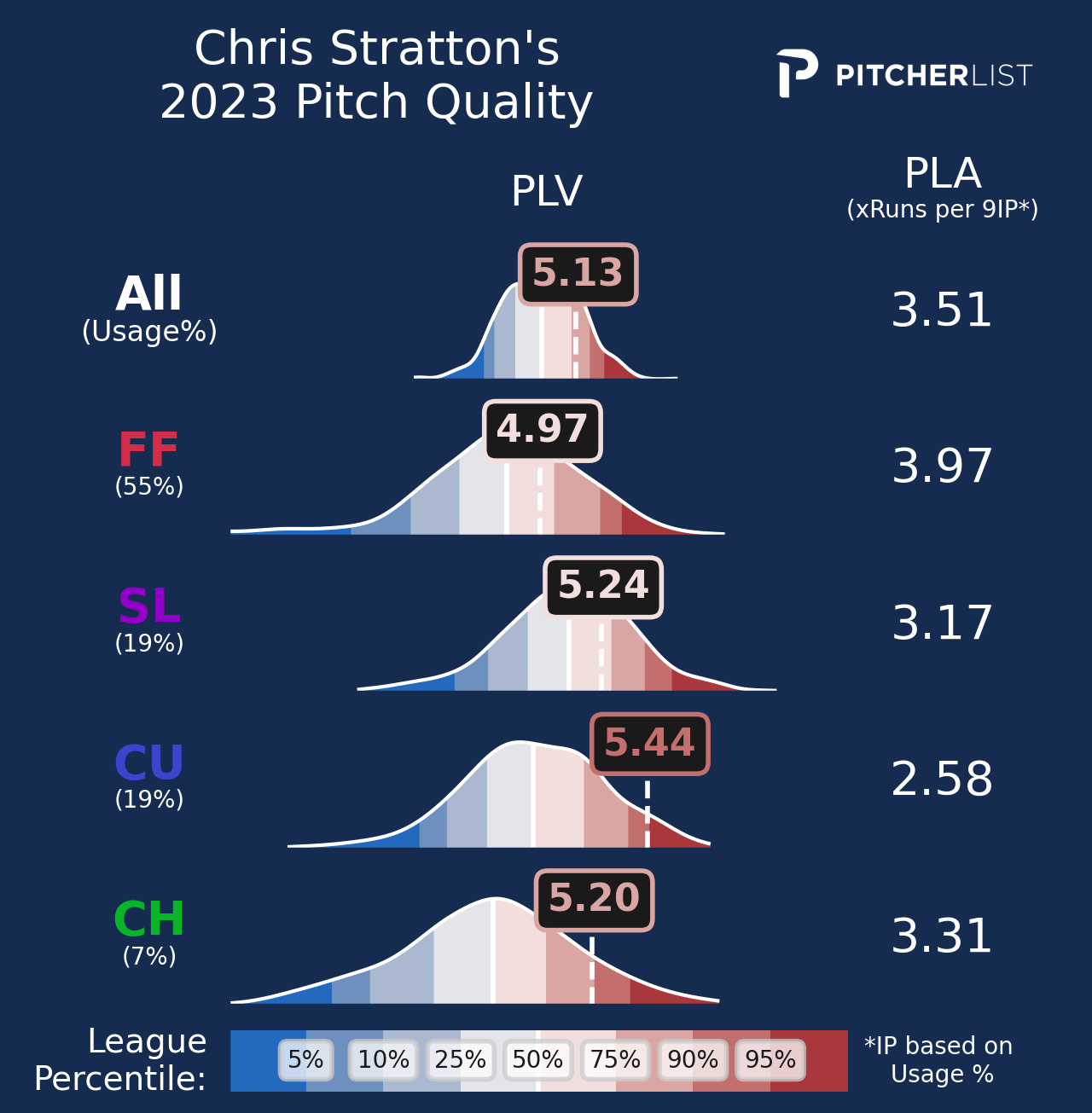What’s up everybody!
I’m in the midst of releasing my annual pitch review series where I take a look back at the five best pitches of each pitch type from 2023, as ranked by PLV! Today, I’m taking a look at the five best curveballs from last year.
If you’d like a closer look at what this series is about, check out the first article in the series on the five best changeups of 2023. And if you’d like an in-depth primer on what PLV is and how it works, check it out here.
Anyway, let’s dive into the five best curveballs of 2023!
Somehow it’s both surprising and not at all surprising that Adam Wainwright is on a list of the best curveballs in baseball. His curveball is one of the all-time greats, and honestly, if someone asked me on the spot to name a great curveball, Wainwright would be one of the first people I’d name.
But it’s also surprising because Wainwright was very bad last year. After posting three straight years with a sub-4.00 ERA and looking like he would defy Father Time, Wainwright went full Hindenburg and crashed and burned, posting a 7.40 ERA over 101 innings and 21 starts. That’s….so bad.
The main problem was his sinker, which was tied for his most-thrown pitch with this curveball. The sinker came in at a measly 87 MPH and got rocked to the tune of a 46.7% ICR, a .495 wOBA against, and a 36.7% home-run-to-fly-ball rate, good god.
But the curveball was pretty solid, posting decent numbers across the board with a 29.8% chase rate and a 40.5% ICR. Not the best but certainly the best among Wainwright’s repertoire. And Wainwright controlled the pitch well too, with just a 4.7% mistake rate on it, which is better than average for curveballs.
Wainwright has since announced his retirement. It’s unfortunate his career ended on such a sour note, but the guy has been one of the most fun pitchers to watch in baseball for years, so I don’t think a bad 2023 is going to tarnish his legacy too much.
Next up on this list is Chris Stratton. After spending a season as a starter with the Giants in 2018, Stratton’s been working as a reliever (with a few starts sprinkled in here and there) basically since 2019, and with mixed results. He’s had good years like 2021 with the Pirates where he posted a 3.63 ERA over 68 games, and he’s had not-so-great years like 2019 with the Angels and Pirates where he posted a 5.57 ERA through 35 games.
Stratton had a solid year last year with the Cardinals and the Rangers out of the bullpen, pitching 82.2 innings with a 3.92 ERA and a 3.53 FIP alongside a decent 24% strikeout rate.
Stratton’s curveball is one of my favorites to watch, I love the way it moves. It comes in around 81 MPH and it has really quick, sharp horizontal break to it alongside its vertical break. In fact, the horizontal break is one of the better features of the pitch—last year Stratton’s curveball had 16.9 inches of induced horizontal break, which is nearly twice the amount of IHB curveballs typically have.
While the curveball produced decent swing-and-miss numbers with a 32.6% chase rate, Stratton mainly used the pitch early in counts to steal a strike, which worked out pretty decently, as he had a 22% called strike rate on the pitch.
The curveball was a solid pitch for Stratton, but his main pitch was his fastball, which he threw over half the time and got pretty decent results with. Then, to put hitters away, he typically moved to either his slider or changeup, the latter of which had a really good 40.8% chase rate and 18.4% swinging-strike rate.
In fact, by PLV, Stratton’s whole arsenal registered as better than average last year:

If he can keep that up this year, he should be a pretty solid relief option for the Royals.
After three straight seasons posting pretty great numbers, Marcus Stroman struggled a bit last year, posting a 3.95 ERA over 25 starts and 136.2 innings.
But you know what didn’t struggle? This curveball. It was Stroman’s second most-thrown pitch behind his sinker and it worked pretty great, posting a 34.3% CSW largely driven by a 22.7% called strike rate, as Stroman used the curveball similarly to Stratton—throwing it early in counts to get a strike by. Still though, its 29% chase rate and 11.6% swinging-strike rate are nothing to sneeze at.
And on top of that, it was pretty good at inducing weak contact, as opposing hitters had a .242 average and .300 wOBA against the pitch (though it’s worth noting opposing hitters also had a 40.9% ICR against the pitch, which isn’t ideal but also isn’t terrible).
Also similar to Stratton’s curveball, Stroman’s is one that’s mostly driven by its horizontal movement, with 14.2 inches of IHB on it last year, well above average for a curveball, and virtually no vertical break (just 1.2 inches of induced vertical break last year).
2. José Berríos
If you’ve ever watched José Berríos pitch, the fact that his curveball is on a list of the best in the league should be no surprise—it’s been his calling card for years and it’s one of my favorite curveballs to watch.
Berríos had a solid year last year, returning to form after a rough 2022, posting a 3.65 ERA over 32 starts and 189.2 innings, and this curveball was a big reason why. Last year, the pitch posted a 35.4% chase rate, 13.8% swinging-strike rate, and a 30.5% CSW, all very solid numbers that are better than average.
Alongside the curveball, Berríos worked in a sinker and a four-seam fastball, primarily sticking with the sinker, which was pretty good at inducing weak contact, inducing a .322 wOBA against and a 38% ICR. It’s also a pitch that gets loads of movement—10.9 inches of induced vertical break last year, well above average.
Meanwhile, the four-seamer produced similar results, with a .320 wOBA against, but also gave up a lot more hard contact with a 47.2% ICR (which is very bad), which helped lead to a .363 xwOBA.
1. Julio Urías
After two straight years of posting a sub-3.00 ERA, Julio Urías had a pretty rough year last year (in more ways than one), posting a 4.60 ERA across 11 starts and 117.1 innings.
The struggles for Urías came from mostly two pitches—his fastball and his changeup. We’ve seen Urías’s fastball drop a couple ticks over the past two years, averaging 94 MPH in 2021 and averaging 92.7 MPH last year. While the reduced velocity worked in 2022, the pitch didn’t work as well last year as it had in the past. In 2022, opposing hitters had a 34.9% ICR against Urías’s fastball—that number jumped up to 38.7% last year, and unsurprisingly, opposing hitters’ wOBA against the pitch jumped up from .271 in 2022 to .345 last year.
All in all, the fastball wasn’t terrible, it just wasn’t as good as it had been in the past (and Urías made more mistakes with it too). But where we really see some bad numbers are with his changeup. Last year, opposing hitters had a 42.9% ICR and a .382 wOBA against the pitch. In 2022, those numbers were 27% and .231, respectively.
But we’re here to talk about his curveball, and if there’s one thing that worked really well for Urías last year, it was his curveball. Opposing hitters had just a 31.5% ICR and .321 wOBA against the pitch and it produced a stellar 40.4% CSW mostly thanks to an extraordinarily high 30.8% called strike rate. Urías frequently used the curveball early in counts to steal a strike and it worked exceptionally well at that, it wasn’t really his putaway pitch (that was supposed to be his changeup, but that didn’t exactly work out).
Obviously, it’s difficult to only talk about baseball when talking about Urías, given he was placed on administrative leave last year following an arrest for felony domestic violence. Currently, Urías is currently a free agent (as of this writing) and we’ll see if any team decides they want to take a chance on him given all the personal baggage that comes with him.
Feature image by Michael Packard (@artbymikep on Twitter) / Photo by Joe Robbins & Brandon Sloter / Icon Sportswire

